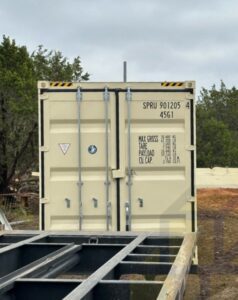Are Shipping Containers Safe to Live In?
Introduction
In the world of alternative housing, shipping container homes have gained traction as a sustainable and affordable housing solution due to their cost-effectiveness, recyclability, and adaptability. However, questions about their structural integrity, insulation, temperature control, and compliance with legal building codes often arise. This article delves into the key aspects that determine the safety, livability, and long-term viability of shipping container homes, offering insights into their benefits, challenges, and necessary modifications to ensure a comfortable living experience.


The Appeal of Shipping Container Homes
Sustainability and Recycling
A major advantage of shipping container homes is their eco-friendly nature. These containers are repurposed, reducing waste and promoting sustainability. By utilizing upcycled containers, homeowners significantly cut down on material consumption, making these homes an eco-friendly alternative to conventional housing. Additionally, integrating sustainable design features such as rainwater harvesting systems, solar panels, and green roofs further enhances their energy efficiency and minimizes their carbon footprint. This combination of repurposing materials and innovative housing solutions makes shipping container homes an attractive choice for those pursuing sustainability goals and waste reduction efforts.
Cost-Effective Housing
Compared to conventional housing, shipping container homes are a cost-effective option. Their affordability makes them ideal for individuals looking for affordable housing solutions without sacrificing durability. In addition to their lower upfront costs, container homes can also lead to long-term savings through energy-efficient living, reduced maintenance costs, and the potential for off-grid sustainability with the integration of solar panels and rainwater harvesting systems. Furthermore, their prefabricated nature allows for faster construction times, reducing labor expenses and making them a viable choice for those seeking efficient and sustainable housing solutions.
Structural Integrity
Weather Resistance
Designed to endure extreme conditions at sea, shipping container homes are highly weather-resistant. Their corten steel (also known as weathering steel) construction provides durability and protection against environmental factors. This steel develops a stable rust-like appearance over time, which acts as a protective layer against further corrosion. Additionally, shipping container homes can withstand extreme weather conditions such as heavy storms, high winds, and even seismic activity when properly reinforced. To further enhance weather resistance, homeowners can apply weatherproof coatings, reinforce seams, and elevate foundations to mitigate flooding risks. These protective measures ensure a secure and long-lasting living environment in diverse climates.
Durability
These containers are built to last, making them a robust housing solution. Their structural integrity allows them to withstand heavy loads and harsh environmental conditions. However, regular maintenance, including rust prevention and sealing joints, is essential to prolong their lifespan. Applying protective coatings, conducting frequent inspections, and reinforcing weak points can prevent deterioration. Additionally, proper foundation placement and weatherproofing enhancements help mitigate environmental wear and tear, ensuring long-term durability and safety.
Insulation and Temperature Control
Avoiding Temperature Extremes
One major concern with shipping container homes is insulation and temperature control. Without proper insulation, containers can become too hot in summer and too cold in winter. The metal walls conduct heat and cold efficiently, making climate control essential for comfort. Various insulation options, such as spray foam insulation, rigid foam panels, and eco-friendly wool insulation, can be used to regulate indoor temperatures effectively. Additionally, incorporating ventilation systems, thermal barriers, and double-pane windows can further enhance energy efficiency and make container homes more comfortable year-round.
Heating and Cooling Solutions
Installing climate control solutions like spray foam insulation, ventilation systems, and energy-efficient heating/cooling units ensures a comfortable indoor environment. Additionally, integrating smart thermostats and automated climate control systems can optimize energy usage and enhance overall efficiency. Homeowners can also consider passive design strategies, such as positioning the container home for optimal natural ventilation and sunlight exposure, to further regulate indoor temperatures and reduce reliance on artificial heating and cooling.
Safety Considerations
Fire Hazards
While the structural integrity of steel containers resists fire, interior materials such as wood paneling and insulation can be flammable. Implementing fire safety measures, such as fire-resistant materials and smoke detectors, is crucial.
Ventilation and Air Quality
Ensuring adequate ventilation prevents moisture buildup, which can lead to mold and poor air quality. Proper airflow and dehumidifiers help maintain a healthy living space.
Pest Control
Sealing gaps and using pest-resistant materials help prevent infestations. Regular inspections ensure a pest-free environment.
Legal and Building Code Considerations
Permits and Zoning Regulations
Before constructing a container home, research local building codes and zoning regulations. Some areas, including North Carolina (NC) and South Carolina (SC), have specific rules regarding container homes.
Building Standards
To ensure safety and compliance, work with container home builders in NC or South Carolina familiar with regulations. Obtaining proper permits is essential.
Design and Customization
Layout and Interior Design
The prefabricated nature of containers allows for design flexibility. You can create open-concept designs, multi-container layouts, and stackable designs for multi-story homes.
Utilities and Amenities
Shipping container homes can accommodate plumbing, electrical systems, and other modern amenities. Customization options allow homeowners to include solar panels, rainwater harvesting systems, and green roofs.
Maintenance and Long-Term Viability
Like any home, shipping container homes require upkeep, including rust prevention, repainting, and routine inspections to maintain structural integrity. In addition to these tasks, homeowners should also consider reinforcing welded seams, applying protective coatings, and regularly checking insulation efficiency to prevent temperature fluctuations. Furthermore, ensuring that proper drainage systems are in place can mitigate water damage and prolong the lifespan of the structure.
Community and Neighborhood Considerations
Living in a container home may raise concerns among neighbors. Open communication about sustainable housing benefits can help foster community acceptance.
Cost Breakdown
Initial Investment
While shipping containers themselves are inexpensive, conversion costs depend on factors like customization, permits, and labor.
Long-Term Savings
Proper insulation, energy-efficient systems, and low maintenance can lead to significant long-term savings on utilities and upkeep.
Real-Life Shipping Container Home Stories
Many homeowners have successfully transformed shipping containers into eco-friendly, sustainable housing solutions. Their experiences highlight the versatility and potential of this housing trend.
Tips for a Safe and Comfortable Living Experience
Invest in Quality Insulation – Proper insulation ensures year-round comfort.
Prioritize Ventilation – Good airflow prevents mold and improves air quality.
Perform Regular Inspections – Routine maintenance helps prevent structural issues.
The Future of Container Living
With rising interest in sustainable shipping container homes, the industry continues to innovate. Eco-friendly alternatives, smart home technology, and advanced structural modifications make container architecture an exciting frontier in modern housing.
Conclusion
Are shipping container homes safe to live in? The answer is yes, provided they are properly insulated, ventilated, and comply with legal building codes. With the right planning, structural reinforcements, and routine maintenance, you can transform a simple steel structure into a comfortable, energy-efficient, and sustainable home. Additionally, integrating smart home technologies, renewable energy sources, and advanced insulation materials can further enhance safety and livability, ensuring a long-term, eco-friendly housing solution.
If you’re considering this unique housing solution, weigh the benefits and challenges carefully. A well-planned shipping container home can be an affordable, sustainable, and structurally sound living space.
By addressing structural integrity, insulation, legal building codes, and sustainability, you can create a safe and comfortable shipping container home that meets your needs!
FAQs
Are shipping container homes legal?
Yes, but regulations vary by location. Check North Carolina (NC) and South Carolina (SC) building codes before starting your project.
Can you make a shipping container home energy-efficient?
Yes! With proper insulation, solar panels, and energy-efficient climate control, container homes can be highly sustainable.
What are the downsides of living in a shipping container?
Potential downsides include limited space, rust issues, and the need for proper insulation and temperature control.
Can I build a two-story shipping container home?
Yes, stackable designs allow for multi-story structures. Ensure proper structural modifications for safety.
How much does it cost to convert a shipping container into a home?
Costs vary based on customization, permits, and labor, but a basic container home can start from a few thousand dollars and go up significantly based on design complexity.
Internal Links to Explore Further
- Do You Need a Permit for a Shipping Container Home? Everything You Need to Know
- Shipping Container Zoning Laws by State: A Complete Guide for Homeowners & Businesses
- Complete Guide: Shipping Container Zoning Laws in All 50 States
- Best Locks for Shipping Containers: Protect Your Cargo with High-Security Solutions
- Best Shipping Container Security Camera Systems: 24/7 Surveillance & Remote Monitoring
- How to Burglar-Proof a Shipping Container: The Ultimate Security Guide
- Fire Safety Tips for Shipping Container Storage
- Shipping Container Fireproofing Methods: Protecting Your Fire-Resistant Storage and Living Spaces
- Insurance for Shipping Container Homes: Everything You Need to Know
- How to Comply with Shipping Container Building Codes: A Step-by-Step Guide
- Seismic Safety for Shipping Container Structures: The Ultimate Guide to Earthquake-Resistant Designs
- Are Shipping Containers Waterproof?
Get quote!

No strings attached 💯